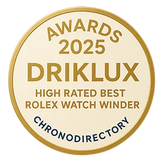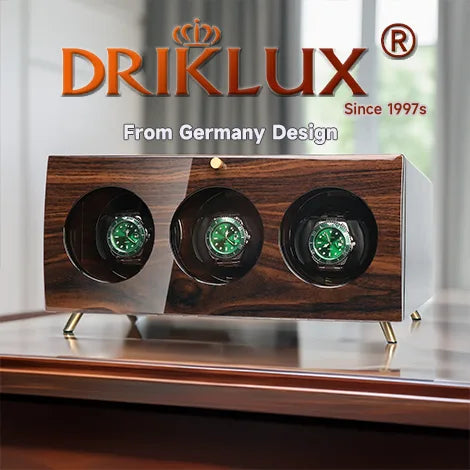Wachwinker verstehen: Ein kritischer Faktor in der Watch Care
Der Winkel, in dem Ihre Uhr im Uhrenbeweger sitzt, ist einer der wichtigsten, aber oft übersehenen Aspekte beim Uhrenaufziehen. Diese ausführliche Anleitung erklärt Ihnen, warum der Aufziehwinkel wichtig ist und wie er die Leistung Ihrer Uhr beeinflusst.
Warum Wicklungswinkel wichtig sind
Die Position Ihrer Uhr im Uhrenbeweger beeinflusst maßgeblich die Aufzugseffizienz und die langfristige Funktionsfähigkeit Ihres Automatikwerks. Unterschiedliche Winkel können die Wechselwirkung des Rotors mit der Schwerkraft beeinflussen und so letztlich den Aufzugsprozess beeinflussen.
Zwei Hauptwinkelkonfigurationen
Vertikale Position (0° zum Boden)
Die vertikale Position bietet mehrere besondere Merkmale:
-
Maximale Effizienz
- Erzeugt eine stärkere Gravitationswirkung auf den Rotor
- Ermöglicht eine direktere Rotorbewegung
- Führt zu schnellerem Wickelvorgang
-
Technische Überlegungen
- Höhere Wahrscheinlichkeit, eine vollständige Wicklung zu erreichen
- Möglicherweise ist eine sorgfältige Überwachung erforderlich, um ein Überdrehen zu verhindern
- Am besten geeignet für Uhren, die eine höhere TPD (Turns Per Day) erfordern
Ausführliche Informationen zu den TPD-Einstellungen finden Sie in unserem Anleitung zur Uhrenbeweger-Einstellung.
45-Grad-Position
Die Schräglage bietet verschiedene Vorteile:
-
Natürliche Bewegung
- Simuliert die tatsächlichen Tragebedingungen am Handgelenk besser
- Sorgt für eine sanftere Wickelwirkung
- Reduziert die Belastung der Bewegung
-
Selbstregulierende Funktionen
- Hilft, ein Überdrehen auf natürliche Weise zu verhindern
- Ermöglicht das Anhalten des Rotors bei zunehmendem Widerstand
- Mehr Fehlertoleranz durch verschiedene Wicklungsmodi
Den richtigen Winkel wählen
Für vertikale Position (0°)
- TPD-spezifische Einstellungen verwenden
- Wickelfortschritt regelmäßig überwachen
- Ideal, wenn ein schneller Aufbau der Gangreserve erforderlich ist
Für 45-Grad-Position
- Empfohlen für den täglichen Gebrauch
- Funktioniert gut mit Modus 3-Einstellungen (bidirektionales Aufwickeln)
- Besser für die Langzeitlagerung
Entdecken Sie unsere TPD Uhrenbeweger-Kollektion für Optionen mit verschiedenen Winkeleinstellungen.
Ergebnisse von Tests in der Praxis
Basierend auf praktischen Beobachtungen:
- Vertikale Positionen zeigen eine höhere Wickeleffizienz
- 45-Grad-Winkel zeigen einen besseren natürlichen Widerstand
- Automatische Rotoren reagieren bei unterschiedlichen Winkeln unterschiedlich
- Bewegungsdesign beeinflusst optimale Winkelwahl
Best Practices für die Winkelauswahl
-
Berücksichtigen Sie Ihren Uhrentyp
- Beachten Sie die Empfehlungen des Herstellers
- Berücksichtigen Sie das Rotordesign
- Berücksichtigen Sie die Anforderungen an die Gangreserve
-
Passend zu Wicklungsmodi
- Vertikale Position: Verwenden Sie kürzere Wickelzyklen
- 45-Grad-Position: Längere Zyklen sind akzeptabel
- Passen Sie die TPD-Einstellungen entsprechend an
-
Leistung überwachen
- Gangreserve beachten
- Überprüfen Sie die Zeitgenauigkeit
- Passen Sie die Position bei Bedarf an
Expertenempfehlungen
Für optimale Ergebnisse:
- Beginnen Sie mit der 45-Grad-Position für die meisten Uhren
- Verwenden Sie die vertikale Position nur, wenn dies für bestimmte Modelle erforderlich ist
- Kombinieren Sie den passenden Winkel mit den richtigen TPD-Einstellungen
- Überwachen Sie regelmäßig die Leistung Ihrer Uhr
Abschluss
Der Aufzugswinkel spielt eine entscheidende Rolle für die Wartung Ihrer Automatikuhr. Sowohl die vertikale als auch die 45-Grad-Position haben ihre Vorteile, wobei der 45-Grad-Winkel bei den meisten Uhren im Allgemeinen ein sichereres und natürlicheres Aufzugserlebnis bietet. Bestimmte Anforderungen können jedoch eine vertikale Position rechtfertigen.
Um optimale Ergebnisse zu erzielen, berücksichtigen Sie die spezifischen Anforderungen Ihrer Uhr und kombinieren Sie den richtigen Winkel mit den entsprechenden Aufzugseinstellungen. Besuchen Sie unsere Anleitung zur Uhrenbeweger-Einstellung für ausführlichere Informationen zur Optimierung der Einstellungen Ihres Uhrenbewegers.
Entdecken Sie unsere Kollektion hochwertiger Uhrenbeweger mit optimalen Winkeleinstellungen bei TPD Uhrenbeweger-Kollektion.
Wie unsere Kunden behandelt werden:
Treue Kunden kommen nicht nur wieder, sie empfehlen Sie nicht nur weiter, sie bestehen darauf, dass ihre Freunde bei Ihnen kaufen. Der Geschäftsgewinn kommt von Stammkunden; Kunden, die von Ihrem Produkt und Ihrem hervorragenden Service schwärmen
















